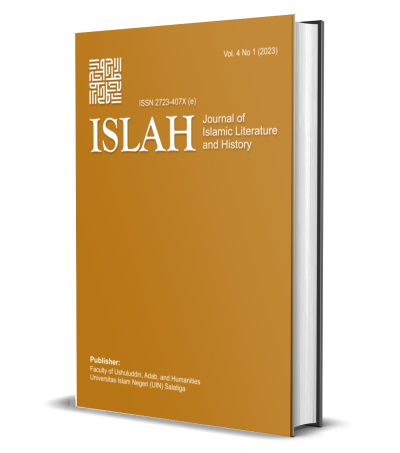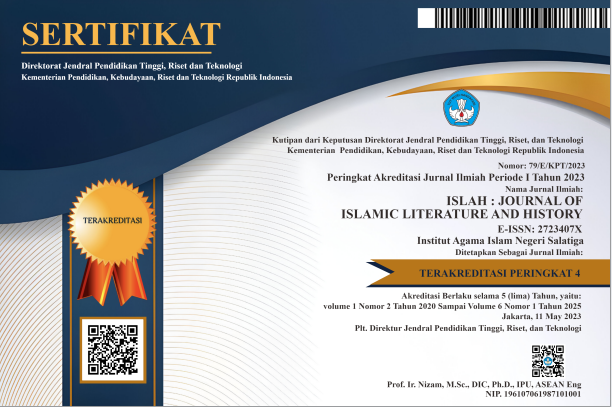The Development of Formal Islamic Educational Institutions in Salatiga in 1932-1998
DOI:
https://doi.org/10.18326/islah.v4i2.179-202Keywords:
Salatiga, Educational Institutions, Formal Islamic EducationAbstract
Islamic Education Institution refers to a place or organization conducting Islamic Education, with a clear structure and responsibility for the implementation of Islamic Education. Islamic education in Salatiga began in 1932. During the Independence period, the education system improved. Since then, formal Islamic education in Salatiga underwent a transformation from the initial marginalization to the proliferation of Islamic educational institutions in all areas of Salatiga. Therefore, this study aims to examine the History and Development of Formal Islamic Education Institutions in Salatiga City from 1932 to 1998. This research applies the historical research method. The stages within the historical research method are (1) Heuristics or data collection, (2) Verification or source criticism, (3) Interpretation or analysis of historical facts, and (4) Historiography or historical writing. The approach in this research is the theory of social change using the concept of formal Islamic Education Institutions and the concept of Islamic education. The results of this study indicate the following: (1) Salatiga is a city of colonial growth and development, from a village to an important city for the colonial authorities. Moreover, it won the De Schoonstestad Van Midden Java or the Most Beautiful City in Central Java award; (2) The emergence of education in Salatiga cannot be separated from the existence of the Dutch government. The Ethical Policy promoted the emergence of educated people in Salatiga; (3) The growth of Dutch educational institutions was inversely compared to formal Islamic educational institutions in Salatiga. It encouraged Muslim scholars to establish formal Islamic educational institutions in Salatiga. HIS Muhammadiyah marks the beginning of formal Islamic educational institutions in Salatiga. The growth and the development of Islamic educational institutions in Salatiga cannot be separated from the government's policy and the initiative of Muslims to build educational systems and institutions appropriate to the times, from primary to tertiary levels.
References
Abbudin Nata, Abbudin. 2015. Kapita Selekta Pendidikan Islam. Jakarta: Raja Grafindo Persada.
Alian, Alian. “Metodologi Sejarah dan Implementasi dalam Penelitian.” Jurnal Pendidikan dan Kajian Sejarah (Criksetra) 2.2 (2012).
Arifyadiputra, Fahrizal Adif. Haris Zaky Mubarak, Salatiga, 2018, “Salatiga dan Singkawang dari Masa Kolonial Ke Awal Kemerdekaan: Potret Dua Kota Plural” . Direktorat Sejarah. Direktorat Jendral Kebudayaan Kementerian Pendidikan dan Kebudayan,
Ashar, Setyoaji, Sigit. 2015. “Tipologi Dan Konsep Integrasi Pada Lingkungan Bangunan Pendidikan Dengan Karakter Arsitek Kolonial Di Jalan Kartini Salatiga”. Tesis, Semarang: Undip.
Biodata Sekolah Swasta (SMP) SMP Islam Sultan Fattah Salatiga tahun 1983- 1993.
Buhtari. 2010. Sejarah Dan Perkembangan Muhammadiyah Salatiga. Salatiga: Perda Muhammadiyah Salatiga.
Buku Profil Yayasan Lembaga Penyelidikan Ilmu- Ilmu Agama Islam dan Dakwah (LPIA)
Data Sekolah Salatiga- Dapodikdasmen. Kementerian Pendidikan, Kebudayaan, Riset dan Teknologi
IAIN Salatiga. 2018. Pedoman Akademik 2018. Salatiga: IAIN Salatiga.
Lukitaningtyas, Dian. 2012, “Sekolah Guru B di Salatiga”. Skripsi. Salatiga: UKSW.
Maharani, Lutvia. 2009. Pengambilalihan Salatiga dari Kekuasaan Belanda ke Pemerintah Republik Indonesia Tahun 1945-1950. Skripsi. Semarang: Universitas Negeri Semarang.
Moehadi, dkk. 1981. Sejarah Pendidikan Daerah Jawa Tengah (Edisi 2). Jakarta: CV. Eka Dharma.
Mutiah, Dewi. 2020, “Dampak Keberadaan Perguruan Tinggi Islam Salatiga terhadap Perubahan Sosial Salatiga (1969- 2014)”, Skripsi. Salatiga: IAIN Salatiga.
Nurlatifah, Ela. 2019. Jilbab Dan Islam Indonesia Masa Orde Baru 1982-1991. Thesis. Jakarta: Fakultas Adab dan Humaniora UIN Syarif Hidayatullah.
Prakosa, Jatayu, Abel. 2017, “Diskriminasi Rasial di Kota Kolonail Salatiga 1917- 1942”. Semarang. Sinar Hidoep.
Profil SMP Islam Sultan Fattah Salatiga.
Rohman, Aprianto, Fandy. 2020, “Administrasi Pemerintah Gemeente Di Salatiga 1917-1942”, Walajusi, Vol. 11. No. 1, Yogyakarta. Kemdikbud.go.id.
Samsudin, Samsudin. Masuk dan Berkembangnya Islam di Provinsi Bengkulu. No. 1. Pustaka Pelajar, 2017.
Sopyana, Asep 2013. “Strategi Pengembangan Kurikulum Pendidikan Agama Islam pada Madrasah Tsanawiyah NU Salatiga Tahun Pelajaran 2012/2013”. Skripsi. STAIN Salatiga.
Supangkat, Eddy. 2007. Salatiga Sketsa Kota Lama (Cetakan Kedua). Salatiga: Griya Media.
Supangkat, Eddy. 2019. Gedung- Gedung Tua Yang Melewati Lorong Waktu Salatiga. Salatiga: Griya Media.
Wardah, E. S. 2020. Metode Penelitian Sejarah. JURNAL TSAQOFAH, 12(02), 163-175.
Widiarto, Dkk. 2006. Sejarah Perkembangan Universitas Kristen Satya Wacana (1956-2006). Salatiga: Widya Sari Press. http://repository.uksw.edu/handle/123456789/479
Zulaicha, Lilik. 2005. “Metodologi Sejarah 1”. Laporan Penelitian. Surabaya: IAIN Sunan Ampel.
Downloads
Published
Issue
Section
License
Copyright (c) 2023 Lutfiana Candra, Juwita Artanti Kusumaningtyas

This work is licensed under a Creative Commons Attribution-ShareAlike 4.0 International License.
Copyright
Authors retain copyright and grant the journal right of first publication with the work simultaneously licensed under a Creative Commons Attribution-ShareAlike 4.0 International License. In line with the license, authors are allowed to share and adapt the material. In addition, the material must be given appropriate credit, provided with a link to the license, and indicated if changes were made. If authors remix, transform or build upon the material, authors must distribute their contributions under the same license as the original.
Licensing

This work is licensed under a Creative Commons Attribution-ShareAlike 4.0 International License.








